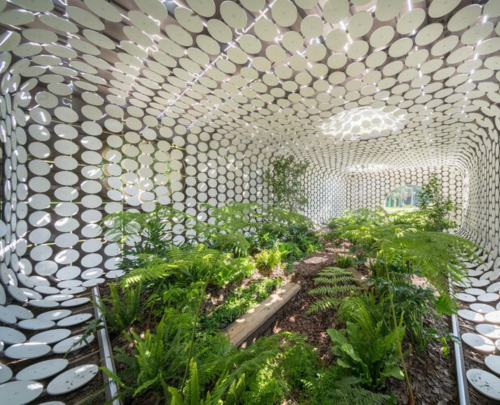Embarking on a riveting journey through uncharted territories within the realm of architecture and design, we find ourselves immersed in a transformative force—a groundbreaking concept that transcends the conventional emphasis on mere visual aesthetics. This avant-garde phenomenon, known as sensory architecture, stands as a vanguard of innovation, positioned at the forefront of a sweeping paradigm shift. Its mission is to reshape not only the appearance but the entire experiential essence of our constructed environment. In this intricate symphony of ingenuity, visionary designers, armed with cutting-edge technologies and innovative techniques, embark on the ambitious endeavour of crafting immersive spaces that beckon us beyond the familiar realms of sight alone. The unfolding of this evolutionary narrative manifests as a mesmerizing dance wherein the senses of touch, smell, taste, and sound converge harmoniously, weaving an intricate tapestry that leaves an indelible mark on the emotional landscape of our existence.

At the forefront of this revolutionary wave is the visionary “Living Architecture” project by luminary Rachel Armstrong—an embodiment of the latent potential within interactive surfaces on a grand scale. Armstrong propels us into a speculative future where buildings, composed of living materials intricately attuned to their surroundings, cultivate a profound relationship with their occupants. The walls and floors, imbued with biological and chemical technologies, transcend their static existence, responding dynamically to touch through changing textures or temperatures. This groundbreaking approach thrusts inhabitants into an immersive tactile embrace, forging a profound and intimate connection between humanity and the architectural spaces they inhabit.

Navigating further through this sensory symphony, we encounter the maestro of lighting design, Sarah Sze, whose seamless collaboration with architects gives birth to dynamic installations that transcend the boundaries of visual experience. Sze’s ability to metamorphose spaces into intricate 3D collages resonates with transformative energy, breathing new life into seemingly mundane environments. A former first-class waiting room near Peckham Rye station becomes a testament to Sze’s capacity to captivate and engage our senses, elevating traditional lighting design to an art form that transcends spatial boundaries.

Venturing deeper into the experiential spectrum, we delve into the olfactory dimension with designer and architect Olafur Eliasson, a pioneering force in integrating ambient scents into spatial experiences. Eliasson elevates architecture to an immersive sensory odyssey through projects like the “Scent Tunnel,” where collaborations with perfumers result in fragrances seamlessly complementing the visual and spatial dynamics of a tunnel-like structure. As visitors traverse through this aromatic tapestry, they become enveloped in subtle scents that elevate spatial awareness, contributing to a multisensory encounter where scent, sight, and memory intertwine seamlessly.

Renowned chef Heston Blumenthal, a virtuoso in culinary arts, extends beyond the boundaries of conventional eateries, seamlessly merging gastronomic expertise with architectural ingenuity. His immersive dining experiences at “The Fat Duck” transcend the realm of gastronomy, incorporating theatrical presentations, sensory surprises, and unique flavour combinations. Blumenthal’s culinary spectacles transform the act of dining into immersive performance art, offering diners a transformative journey that extends beyond the plate, creating enduring memories that linger in the recesses of the mind.

In this sensory odyssey, sound artist Janet Cardiff assumes a central role, crafting installations that weave rich and dynamic soundscapes. The magnum opus “The Forty Part Motet” is a testament to Cardiff’s unparalleled brilliance, as she reinterprets a choral piece by Thomas Tallis, orchestrating individual voices through a circular arrangement of speakers. Visitors traverse the space, ensconced in a symphony of harmonious sounds, undergoing an intimate and transformative encounter. Cardiff’s masterful use of spatial audio technology engages the sense of hearing, transporting individuals into immersive auditory landscapes that redefine the boundaries of sonic experience.

Sensory architecture is not merely a fleeting trend but a profound revolution in how we engage with the built environment. From interactive surfaces and dynamic lighting to ambient scenting, culinary sensory spaces, and dynamic soundscapes, designers are crafting environments that transcend the visual, stimulating our senses and evoking profound emotional responses. These projects represent a departure from traditional architectural norms, inviting individuals on multisensory odysseys that linger in the tapestry of memory. Sensory architecture not only elevates the aesthetic appeal of spaces but also creates meaningful and enduring experiences, carving out a new paradigm in design evolution.

As this field continues to unfurl its wings, we eagerly anticipate more captivating designs that push the boundaries, transforming our perception and experience of the world around us into an ever-evolving, multisensory tapestry of unparalleled richness and depth. Here, the fusion of architecture and the human sensorium becomes an art form in perpetual evolution, beckoning us into a realm where the immersive and the extraordinary merge, creating a narrative that transcends the boundaries of conventional design, opening up new frontiers for the exploration of the human experience in the constructed environment.


